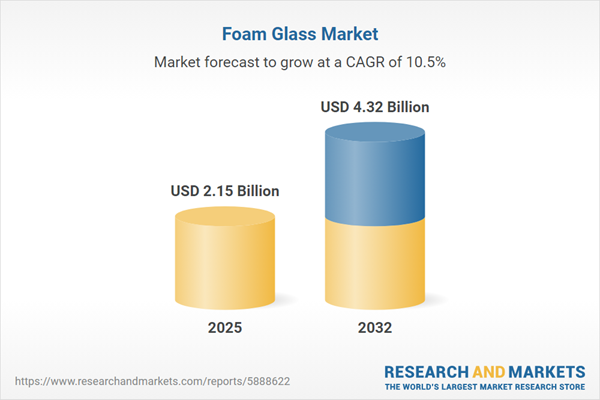Speak directly to the analyst to clarify any post sales queries you may have.
Foam glass is emerging as a priority material for organizations seeking both sustainable growth and operational efficiency. Senior leaders are increasingly evaluating this solution to address regulatory compliance and infrastructure performance while strengthening long-term competitive positioning in key sectors.
Foam Glass Market Snapshot
The foam glass market is showing robust growth momentum, with revenue projected to rise from USD 1.95 billion in 2024 to USD 2.15 billion in 2025, and long-term estimates anticipate revenue reaching USD 4.32 billion by 2032, representing a compound annual growth rate (CAGR) of 10.45%.
Expansion is primarily fueled by heightened demand across the construction, industrial, and horticultural industries, as organizations pursue greater sustainability and durability in material choices. Manufacturers are leveraging advancements in production technologies to improve differentiation and reliability within their product portfolios. Market evolution is also shaped by varying global regulatory frameworks, which encourage innovation while promoting regionally tailored insulation, fire protection, and resilient performance. Active sector engagement supports supplier adaptation and fosters product improvement aligned with evolving industry standards.Scope & Segmentation of the Foam Glass Market
- Application: Used for delivering high-performance insulation and fire safety in commercial and residential buildings; reinforces sustainable practices in urban agriculture projects; ensures chemical resistance in surrounding environments for industrial processes focused on environmental sensitivity.
- Product Form: Beads provide advantages for lightweight or flexible horticultural applications; blocks withstand demanding insulation requirements in large structures; granules are used for loose-fill insulation and helping fulfill specialized landscaping needs.
- End Use: Enhances energy efficiency in properties and meets strict standards for fire safety; supports sustainable landscaping in both public spaces and private developments; encourages new approaches in horticultural enterprise operations.
- Distribution Channel: Sold through direct procurement, original equipment manufacturer agreements, wholesale distributorship, value-added reseller networks, and digital buying platforms—each channel streamlining accessibility for end users.
- Geographic Coverage: Americas, Europe, Middle East and Africa, and Asia-Pacific are the main regions with notable adoption. Asia-Pacific benefits from fast-paced industrial development, while North America and Western Europe leverage established regulatory frameworks to support market stability. Other regions customize foam glass applications to suit local standards and industry-specific challenges.
- Leading Companies Analyzed: Industry growth is driven by influential organizations including Pittsburgh Corning Corporation, Owens Corning, Saint-Gobain S.A., Rockwool International A/S, Johns Manville Corporation, Knauf Insulation GmbH, Armacell International S.A., GCP Applied Technologies Inc., URSA Insulation S.A., and Xella International GmbH, each noted for innovation and focused market strategies.
Key Takeaways for Senior Leaders
- Foam glass aligns with organizational sustainability objectives, enhancing risk management within projects that require modernized infrastructure and consistent performance.
- Utilizing recycled content and digital monitoring ensures efficient supply chain management and supports high standards of product quality for mission-critical deployments.
- Innovation in horticultural and specialized applications is broadening the market. This trend prompts organizations to reassess alignment strategies and adapt to expanding opportunities across diverse sectors.
- Expanding access through direct sales and integrated technology partnerships helps organizations anticipate change and refine supply priorities in increasingly complex environments.
- Regional regulations and unique industry settings dictate implementation strategies, encouraging the adoption of best practices and catalyzing cross-sector learning.
Tariff Impact: Strategic Responses to New U.S. Policy
Recent U.S. tariffs have pushed domestic manufacturers to increase production capacity, while importers are reviewing their sourcing strategies. As a result, stakeholders are pursuing longer-term supply contracts, expanding supplier networks, and investing in modern processing solutions. These responses offer means of effective cost management and ensure reliable delivery for sectors sensitive to tariff fluctuations.
Research Methodology & Data Sources
This analysis applies a rigorous mixed-method methodology, centered on qualitative interviews with senior executives, technical experts, and procurement leaders. The insights are corroborated by industry reports and official regulatory resources. Analytical models such as Porter’s Five Forces and PESTEL have been used to deliver actionable market intelligence relevant to B2B decision-makers.
Why This Report Matters
- Helps senior leaders identify target growth segments and track benchmarks for sustainability in the foam glass market.
- Delivers practical guidance to support sourcing, regulatory compliance, and competitive differentiation within industries prioritizing resilient solutions.
- Prepares organizations to cultivate flexible procurement strategies that keep pace with emerging operational and supply chain trends.
Conclusion
This report equips decision-makers with clear insight to advance innovation, uphold compliance, and reinforce supply planning as foam glass plays a growing strategic role internationally.
Additional Product Information:
- Purchase of this report includes 1 year online access with quarterly updates.
- This report can be updated on request. Please contact our Customer Experience team using the Ask a Question widget on our website.
Table of Contents
3. Executive Summary
4. Market Overview
7. Cumulative Impact of Artificial Intelligence 2025
Companies Mentioned
The companies profiled in this Foam Glass market report include:- Pittsburgh Corning Corporation
- Owens Corning
- Saint-Gobain S.A.
- Rockwool International A/S
- Johns Manville Corporation
- Knauf Insulation GmbH
- Armacell International S.A.
- GCP Applied Technologies Inc.
- URSA Insulation S.A.
- Xella International GmbH
Table Information
| Report Attribute | Details |
|---|---|
| No. of Pages | 194 |
| Published | October 2025 |
| Forecast Period | 2025 - 2032 |
| Estimated Market Value ( USD | $ 2.15 Billion |
| Forecasted Market Value ( USD | $ 4.32 Billion |
| Compound Annual Growth Rate | 10.4% |
| Regions Covered | Global |
| No. of Companies Mentioned | 11 |









